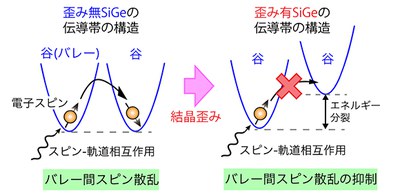
Application of in-plane and biaxial tensile strain to a semiconductor extends the spin lifetime
A group of researchers from Osaka University and Tokyo City University has significantly extended spin lifetime in lateral spin-valve (LSV) devices with a strained silicon (Si) germanium (Ge) layer.
Electrons’ spin produces a small magnetic moment. The spin property serves as a tiny magnet, which allows the spin to store information. Magnets are formed when many electrons align their individual moments in the same direction. Use of the spin degree of freedom in semiconductor devices is a key to the development of next-generation electronic devices, and the spin degree of freedom in semiconductors can be manipulated through electrical spin-injection into nonmagnetic semiconductor heterostructures.
Spin lifetime is the length of time in which the spins retain their alignment before their directions randomize, therefore erasing the stored information. Longer spin lifetime is preferable from an application perspective. However, even if spins in general semiconductors are distributed equally in all directions, they become unpolarized in a short period of time. This phenomenon is called “spin relaxation.” When spin relaxation occurs, the spin information will be lost. The distance of the electron travels in time is called the "spin relaxation length."
SiGe is a widely-used semiconductor material for the advanced Si-CMOS (complementary metal oxide semiconductor) and researchers strive to create semiconductor spin devices with non-volatile memory through electrical spin injection into a channel of group-IV semiconductors such as Si and Ge.
The valleys in the energy bands indicate the points where an electron has minimum energy. Intervalley scattering is suppressed when energy splitting between valleys becomes large. The intervalley-spin-flip-scattering process in Si or Ge devices can be controlled by lifting the valley degeneracy in the conduction band.
General group-IV semiconductors are expected to transport long-lived spin information because of their large spin diffusion length and long spin lifetime. Intervalley-spin-flip-scattering is directly related to spin lifetime and determines the performance of group-IV semiconductors.
For intrinsic Si and Ge, the spin relaxation of electrons has been theoretically suggested to be dominated mainly by the electron-phonon interaction inducing spin-flip transitions between the degenerate multivalley conduction bands (i.e., intervalley spin-flip scattering), but this has not been verified experimentally.
In this study, the group used SiGe as a spin-transport layer because effective in-plane and biaxial tensile strain could be induced by forming a high-quality SiGe/Ge heterostructure.
They fabricated LSV devices with various center-to-center distances between the spin injector and the detector (where the information can be read), applying an in-plane and biaxial tensile strain to the SiGe layer. This structure suppressed intervalley spin-flip scattering of electrons in the spin conduction, caused the energy splitting of the conduction-band valleys in SiGe, and extended spin lifetime significantly.
In addition, use of stained SiGe spin-transport layer extended spin lifetime and enhanced spin signals in the strained-SiGe devices to 2 orders of magnitude larger than those in strain-free-SiGe devices at low temperatures. This suggests that spin lifetime in general group-IV semiconductors such as Si and Ge could be extended.
This group has made a significant contribution to opening a path to practical use of group IV semiconductors. Their achievements will provide a key to the development of high performance and ultra-low-power-consumption devices.
Figure 1
Figure 2
The article, “Suppression of Donor-Driven Spin Relaxation in Strained Si 0.1 Ge 0.9,” was published in Physical Review Applied at DOI: https://journals.aps.org/prapplied/abstract/10.1103/PhysRevApplied.13.054025
Related links
Hamaya Laboratory, Interactive Materials Science Cadet, Graduate School of Engineering Science (link in Japanese)
